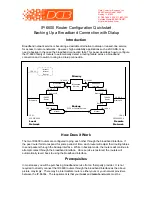
Data Comm for Business, Inc.
2949 County Road 1000 E
Dewey, IL 61840
217-897-6600, FAX 217-897-1331
Outside Illinois: 800-4DCBNET
http://www.dcbnet.com
8. Serial-B PPP Options
– Configure the PPP options to connect with the local router. For our
example, we are simply waiting for an incoming call. From the default configuration, set the
Connection Type to Modem and set Dial-in to yes.
9. Serial-B Static Routes
– Set a default route through the PPP connection. This would be an
entry of Target: 0.0.0.0, Netmask: 0.0.0.0, Failover: Yes. Notice that this is a failover route.
Its counterpart was set back on step 5.
10. Serial-B Modem Options
– Set the modem options appropriate for your modem.
The remote IP6600 is configured. Don’t forget to activate and save your changes.
Dial On-Demand
In our example, we configured the backup PPP connection to be immediately established on
failure of the broadband connection. However, you may want the connection established only if
there is also traffic destined for the remote network. You can accomplish this by changing dial-
out mode to on-demand. This will cause the connection to be established when the broadband
fails but only if there is active traffic to the remote network.
One additional note, never enable dial-out on-demand on both routers. This will likely cause a
deadlock between the routers since they will attempt to dial at approximately the same time
resulting in a busy phone line.
The Failover and Recovery Times
On the Failover Configuration screen there are two timer values, Failover Time and Recovery
Time. These timers control the rate at which the peer router is pinged, and consequently how
responsive the router is to failure detection and recovery. When your primary interface is up, the
router will ping its target at 5 times the “Failover-Time” rate. So, for example, if set to 30
seconds, the target will be pinged once every 6 seconds. Five consecutive non-responses
triggers the switch to the backup interface. The router will then attempt to ping its target a 5 times
the “Recovery-Time” rate. Five consecutive successful responses will trigger the switch back to
the primary interface.
When using dial-up modems for your backup route, there is an adjustment that you should make
to the Failover-Time. Set the Failover-Time on the dial-out router to be 5 seconds greater than
the dial-in router. This allows time for the dial-in modem to be configured prior to receiving the
call from the dial-out router.

























